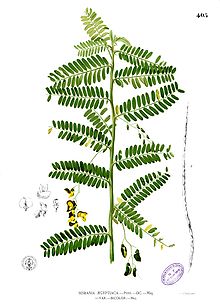Sesbania sesban
| Sesbania sesban | |
|---|---|

| |
| Scientific classification | |
| Kingdom: | Plantae |
| Clade: | Tracheophytes |
| Clade: | Angiosperms |
| Clade: | Eudicots |
| Clade: | Rosids |
| Order: | Fabales |
| Family: | Fabaceae |
| Subfamily: | Faboideae |
| Genus: | Sesbania |
| Species: | S. sesban
|
| Binomial name | |
| Sesbania sesban | |
Sesbania sesban, the Egyptian riverhemp,[1] is a species of plant in the legume family, a fast growing species, it has four varieties that are currently recognized.[2][3]
Synonyms include:
- Aeschynomene aegyptiaca (Pers.) Steud.
- Aeschynomene sesban L.
- Emerus sesban (L.) Kuntze
- Sesbania aegyptiaca Poir.
Description[edit]
A perennial shrub or small tree that grows up to 6 m tall sometimes reaching 8 m.[citation needed] It has paripinnately compound leaves with between 6-27 pairs of linear to oblong leaflets per pinnae; the leaves and rachis tend to be pilose. Flowers are yellow in color with brown and purple streaks on the corolla.
Distribution and habitat[edit]
Sesbania sesban occurs widely in tropical East and West Africa, in Southern Africa and in Asia.[4] Commonly found on a variety of soil types including loose sandy soil and clay soil, it grows in areas with annual rainfall of between 500-2000 mm.[3]
Infraspecies[edit]
- Sesbania sesban var. bicolor (Wight & Arn.) F.W.Andrews
- Sesbania sesban var. nubica Chiov.
- Sesbania sesban subsp. punctata (DC.) J.B.Gillett
- Sesbania sesban subsp. sesban
Uses[edit]
Sesbania sesban is a nitrogen-fixing tree and may be useful in alley cropping. It is also used as a fodder crop and source of fuel wood.[5]
References[edit]
- ^ USDA, NRCS (n.d.). "Sesbania sesban". The PLANTS Database (plants.usda.gov). Greensboro, North Carolina: National Plant Data Team. Retrieved 10 November 2015.
- ^ "Sesbania sesban (L.) Merr. | Plants of the World Online | Kew Science". Plants of the World Online. Retrieved 2023-12-14.
- ^ a b Heering, J.H. (1995). Botanical and agronomic evaluation of a collection of Sesbania sesban and related perennial species (PhD thesis). Wageningen University.
- ^ Heering, J. H.; Nokoe, S.; Jemal, M. (1996). "The classification of a Sesbania sesban (sesban) collection. I. Morphological attributes and their taxonomic significance". Tropical Grasslands. 30 (2). ISSN 0049-4763.
- ^ Palsaniya, Dana Ram; Kumar, T. Kiran; Chaudhary, Manoj; Choudhary, Mukesh; Prasad, Mahendra; Kumar, Sunil (2023-10-15). "Tillage practices and mulching affect system productivity, profitability and energy use in Sesbania alley based food - fodder systems under rainfed agro-ecosystems of semi-arid tropics". Field Crops Research. 302: 109104. doi:10.1016/j.fcr.2023.109104. ISSN 0378-4290.
Relevant literature[edit]
- Ramni Jamnadass, Jean Hanson, Jane Poole, Olivier Hanotte, Tony J. Simons, Ian K. Dawson. High differentiation among populations of the woody legume Sesbania sesban in sub-Saharan Africa: Implications for conservation and cultivation during germplasm introduction into agroforestry systems. Forest Ecology and Management Volume 210, Issues 1–3, 2005, Pages 225–238, ISSN 0378-1127, https://doi.org/10.1016/j.foreco.2005.02.033.
External links[edit]
